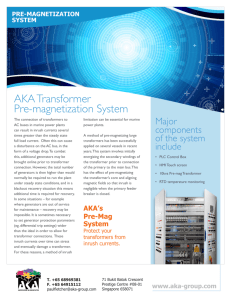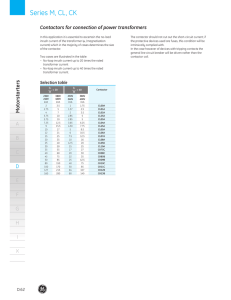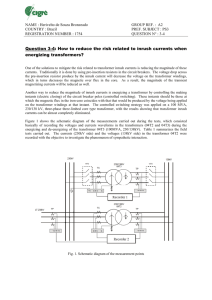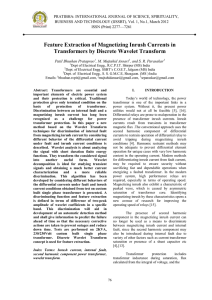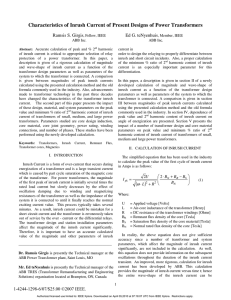A STUDY ON MAGNETIZING INRUSH CURRENT OF DIFFERENT
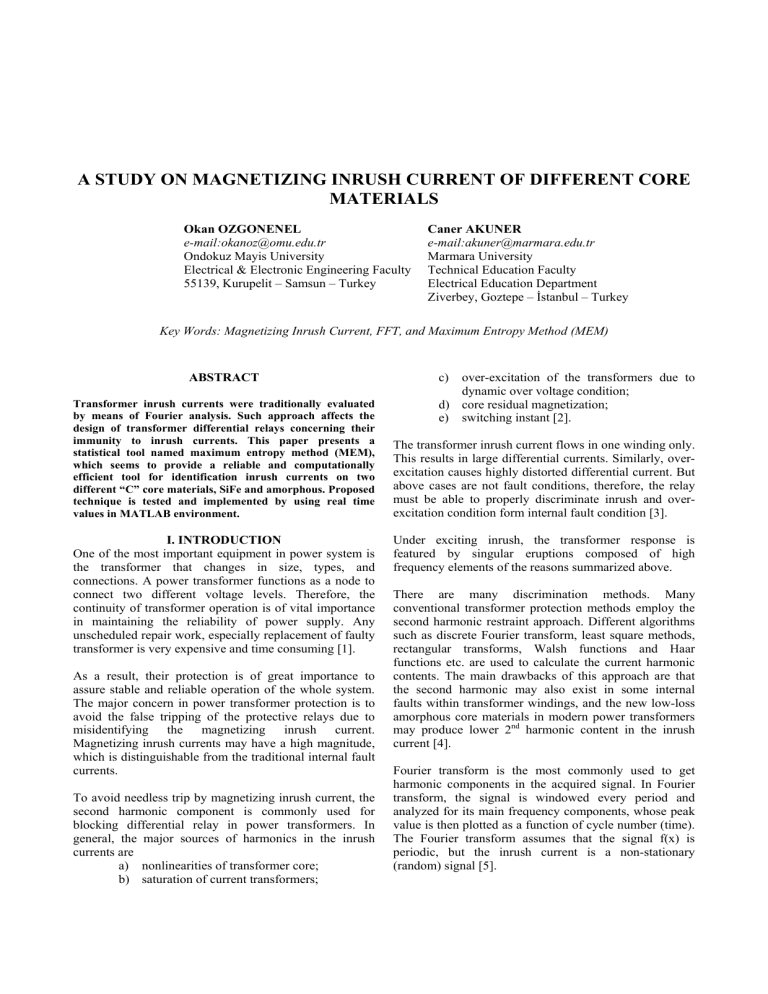
A STUDY ON MAGNETIZING INRUSH CURRENT OF DIFFERENT CORE
MATERIALS
Okan OZGONENEL e-mail:okanoz@omu.edu.tr
Caner AKUNER e-mail:akuner@marmara.edu.tr
Ondokuz Mayis University
Electrical & Electronic Engineering Faculty
55139, Kurupelit – Samsun – Turkey
Marmara University
Technical Education Faculty
Electrical Education Department
Ziverbey, Goztepe – İ stanbul – Turkey
Key Words: Magnetizing Inrush Current, FFT, and Maximum Entropy Method (MEM)
ABSTRACT
Transformer inrush currents were traditionally evaluated by means of Fourier analysis. Such approach affects the design of transformer differential relays concerning their immunity to inrush currents. This paper presents a statistical tool named maximum entropy method (MEM), which seems to provide a reliable and computationally efficient tool for identification inrush currents on two different “C” core materials, SiFe and amorphous. Proposed technique is tested and implemented by using real time values in MATLAB environment.
I. INTRODUCTION
One of the most important equipment in power system is the transformer that changes in size, types, and connections. A power transformer functions as a node to connect two different voltage levels. Therefore, the continuity of transformer operation is of vital importance c) over-excitation of the transformers due to dynamic over voltage condition; d) core residual magnetization; e) switching instant [2].
The transformer inrush current flows in one winding only.
This results in large differential currents. Similarly, over- excitation causes highly distorted differential current. But above cases are not fault conditions, therefore, the relay must be able to properly discriminate inrush and over- excitation condition form internal fault condition [3].
Under exciting inrush, the transformer response is featured by singular eruptions composed of high frequency elements of the reasons summarized above.
There are many discrimination methods. Many conventional transformer protection methods employ the in maintaining the reliability of power supply. Any unscheduled repair work, especially replacement of faulty transformer is very expensive and time consuming [1].
As a result, their protection is of great importance to assure stable and reliable operation of the whole system.
The major concern in power transformer protection is to second harmonic restraint approach. Different algorithms such as discrete Fourier transform, least square methods, rectangular transforms, Walsh functions and Haar functions etc. are used to calculate the current harmonic contents. The main drawbacks of this approach are that the second harmonic may also exist in some internal faults within transformer windings, and the new low-loss avoid the false tripping of the protective relays due to misidentifying the magnetizing inrush current.
Magnetizing inrush currents may have a high magnitude, which is distinguishable from the traditional internal fault currents. amorphous core materials in modern power transformers may produce lower 2 nd harmonic content in the inrush current [4].
Fourier transform is the most commonly used to get
To avoid needless trip by magnetizing inrush current, the second harmonic component is commonly used for blocking differential relay in power transformers. In general, the major sources of harmonics in the inrush currents are a) nonlinearities of transformer core; b) saturation of current transformers; harmonic components in the acquired signal. In Fourier transform, the signal is windowed every period and analyzed for its main frequency components, whose peak value is then plotted as a function of cycle number (time).
The Fourier transform assumes that the signal f(x) is periodic, but the inrush current is a non-stationary
(random) signal [5].
Recently, Wavelet based differential transformer protection algorithms are presented as a new signal conditioning method because of its ability to extract information from the transient signals simultaneously in both time and frequency domain, rather than conventional
Fourier transform which can only give the information in the frequency domain [6].
Interpreting the DWT coefficients can sometimes be rather difficult because of the way DWT coefficients are presented. Wavelet coefficients are of inner product of the signal and a wavelet basis. Thus, the cross-correlation function and the similarity between the signal and wavelet basis are only interpreted. In practice, wavelet and neural network approach are used to get frequency information.
II. AN OVERVIEW OF STOCHASTIC PROCESS
The study of random signals and methods of power spectrum estimation is a rather challenging discipline because the level of mathematics needed for a rigorous presentation of stochastic process is high. On the other hand, many of the algorithms used to perform spectrum estimation are relatively easy to implement in a language such as MATLAB. Furthermore, an understanding of these algorithms and their performance is often gained through simulation.
The objective of this paper is to present the essential information about power spectrum estimation for a stochastic process such as inrush condition and relate the theoretical formulas. In the study of spectrum estimation, we concentrate on the implementation of FFT and MEM.
The inrush currents we have to deal with in practice are, in most cases, not deterministic as seen in Figure 1. probability density function, joint density function, mean, autocorrelation, and so on [7]. From this point of view, this paper deals with autocorrelation function of the sampled signals to get the autocorrelation matrix of MEM explained in the next section.
These calculations must be estimated using measurement on a finite set of data. The direct Fourier transform of the random signal is not a useful quantity. As in the case of deterministic signals, a harmonic description in both time and frequency domains is of interest.
To achieve this goal in this paper, a sliding window
Fourier transform is applied to sampled data and variations of DC, second and fifth harmonic components over fundamental harmonic component are obtained and plotted.
III. PROPOSED TECHNIQUE (MEM)
The maximum entropy method (for a sinus process) produces a spectrum estimate in the form of an all-pole spectrum.
P mem
(sin( wt ) a
1 sin( wt ) + a
2
=
G
2
A (sin( wt ))
Expansion of Eq. (1) is expressed as below:
1 +
G
2 sin( 2 wt ) + ...
+ a
N
(1) sin( Nwt )
2
(2) where G is the gain, a
1
, .. a
N
coefficients, N number of the poles and P is the power spectrum of the signal.
The calculation of the parameters {G, a
1
, .. a
N
} can be done by solving a set of (N+1) x (N+1) linear equations, which are the normal equations of a least-squares minimization problem defined in Eq. (3).
ac ac
...
ac [
[
[
0
1 ]
N
]
] ac
*
[ 1 ] ac [ 0 ]
...
...
...
ac * [ 1 ]
...
ac [ 1 ] ac
*
[
...
...
N ac [ 0 ]
]
.
a
1 a
1
...
N
=
G
0
...
0
2
(3)
These equation ( ac[..] ) are based on the autocorrelation sequence of the signal being analyzed. This sequence is defined as:
Figure 1. Magnetizing inrush current for SiFe core transformer
A stochastic signal such as inrush current has two important specifications: at a fixed time instant its value of harmonic content is a random variable, and as a function of time the random variables might be interrelated. Generally speaking, the definition of the random signal is done via its statistical properties:
The signal f ac [ l ] =
( x )
1
N k
N
∑
= 1
+ l ) (4)
must be extended by padding zeros whenever the argument f ( x )
*
[ k ].
f ( k
( k + l ) in (4) is greater than N.
A. Laboratory Experiments
In laboratory environment, two transformers are used with a different core material types, SiFe and amorphous. Real time data are collected over PCI - NI-DAQ, 12 bit,
1.25GS data acquisition card. A number of experiments regarding different switching instants are implemented by a manually controlled switch. Experimental set-up is shown in Figure 2. coefficients are shown for the last period of the inrush current (containing only 5 samples) below:
Ac=
0.0028 0.0022 0.0016 0.0010 0.0004
0.0022 0.0028 0.0022 0.0016 0.0010
0.0016 0.0022 0.0028 0.0022 0.0016
0.0010 0.0016 0.0022 0.0028 0.0022
0.0004 0.0010 0.0016 0.0022 0.0028 a
1 a
2
= 1.0000
= -0.8360 a a a
5
3
4
= 0.0207
= 0.0216
= 0.1016
MEM estimation for the last period is shown in Figure 4.
Figure 2. Experimental set-up in laboratory environment.
, is set to 2000Hz, which Sampling frequency, F
S corresponds 40 samples per cycle. In FFT and MEM calculation, sliding window range is performed over a period including 40 samples per calculation. Following outcomes are obtained:
Case 1: Transformer with SiFe core material
Figure 3 shows the harmonic components regarding FFT approach. In Figure 3, DC, second and fifth harmonic components are plotted with respect to time.
Figure 3. DC, second and fifth harmonic components for
SiFe core material
In MEM approach, autocorrelation estimation is done according to Eq. (1) – Eq. (3). As it is seen in those equations, there are two unknown on both sides of Eq.
(3). The lower N equations must be solved first for the coefficients {ac[]}, then G can be found. A sample aurocorrelation matrix and its corresponding a
N
Figure 4. MEM estimation of harmonics for the last period (40 samples used)
In Figure 4, autocorrelation matrix {40 x 40} and 39 related coefficients are calculated.
Case 2: Transformer with Amorphous core material
Figure 5 shows inrush current and its harmonic components regarding FFT approach. In Figure 5, DC, second and fifth harmonic components are plotted with respect to time.
As it is seen form the Figure 3 and Figure 5, the transformer with amorphous core material exhibits low harmonic components rather than the one with SiFe material does.
MEM estimation for the last period is shown in Figure 6.
Figure 5. Inrush current and its harmonic components with respect to time.
Figure 6. MEM estimation of inrush current for the last period
IV. CONCLUSION
In this work a new algorithm for discriminating inrush current is presented. The proposed algorithm is based on a statistical approach called maximum entropy method, which is often used for stochastic signal analysis. This new method is compared with the classical short time
FFT approach. It can be concluded that MEM approach is able to extract harmonic component as well as FFT. MEM calculation is simple to implement and based on solving linear combination of equations in sense with least – square approximation.
REFERENCES
[1] F. Jiang and et all, Power Transformer Protection
Based On Transient Detection Using Discrete Wavelet
Transform (WT), Power Engineering Society Winter
Meeting, 2000. IEEE , Volume:3,23-27Jan.2000 Page(s):
1856 -1861 Vol.3.
[2] Omar A.S. Youssef, A Wavelet-Based Technique for
Discrimination Between Faults and Magnetizing Inrush
Currents in Transformer, IEEE Transactions on Power
Delivery, Vol. 18, No. 1, January, 2003.
[3] Dr. K.P. Vittal, D.N. Gaonakar, Dr. D.B. Fakruddin,
“Development of Wavelet Transform Based Numeric
Relay for Differential Protection of Power Transformer”,
TENCON 2003. Conference on Convergent Technologies for Asia-Pacific Region, Volume 4, 15-17 Oct. 2003
Page(s):1580 - 1584 Vol. 4.
[4 Saleh, S.A., Rahman, M.A
., Off-line Testing of a
Aavelet Packet-based Algorithm for Discriminating
Inrush Current in Three-phase Power Transformers,
Power Engineering, 2003 Large Engineering Systems
Conference on , 7-9 May 2003, Page(s): 38 -42.
[5] Moises Gomez-Morante, Denise W. Nicoletti, A
Wavelet Based Differential Transformer Protection, IEEE
Transactions on Power Delivery, Vol. 14, No. 4, October,
1999.
[6] Peilin L. Mao, Raj K. Aggarwal, A Novel Approach to the Classification of the Transient Phenomena in Power
Transformers Using Combined Wavelet Transform and
Neural Network, IEEE Transactions on Power Delivery,
Vol. 16, No. 4, October, 2002.
[7] James H. McClellan et all , “Computer-Based
Exercises for Signal Processing Using MATLAB 5”,
Prentice Hall, Upper Saddle River, New Jersey 07458.
APPENDIX
Transformers have the same specifications such as:
1.
Transformer With Iron Core (SiFe)
N
1
= 1250 turns, N
2
=193 turns, 220V / 40V, f=50Hz,
Magnetic path= 290 mm, Lamination thickness= 0.1mm. d
1
=1.55mm, d
2
=0.70mm
2.
Transformer With Amorphous Core
N
1
= 1250 turns, N
2
=193 turns, 220V / 40V, f=50Hz,
Magnetic path= 290 mm, d
1
=1.55mm, d
2
=0.70mm
